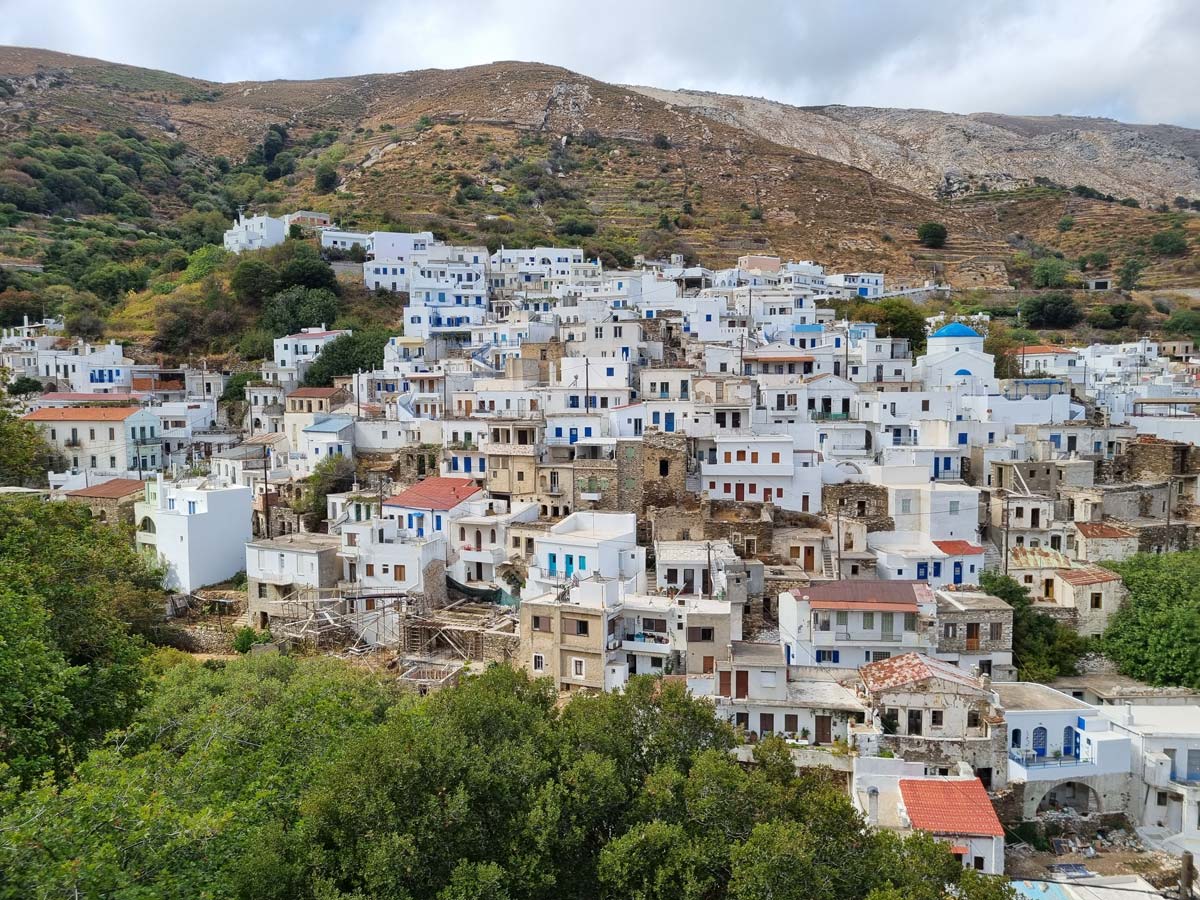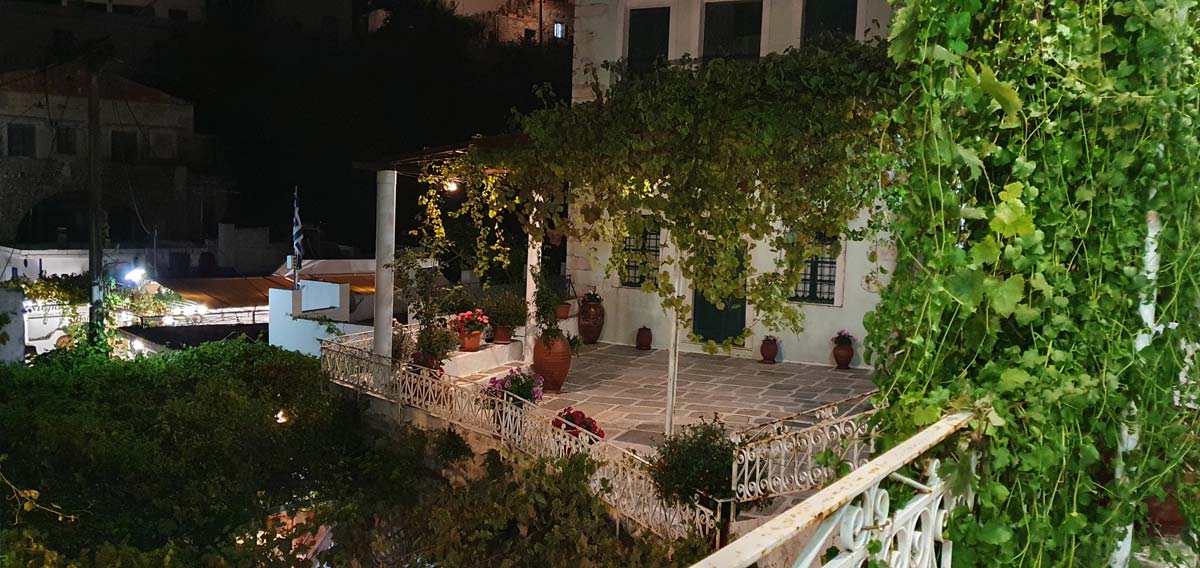Koronos village, located in the northeast part of island, we would easily call it “The little Italy of Naxos”. Dramatic village landscape, unspoiled nature, mountaineous grandeur and raw life awaits you at Koronos. It’s a peaceful village built on a ravine with two halves that face each other and surrounded with vineyards, at an altitude of 540 m. The beautiful colored homes are cascading down the rocky slopes, and picturesque narrow cobblestone alleys with stairways full of history and tradition. The most astonishing of Koronos village is its abrupt uphill roads with the endless whitewashed cemented steps.

The extraordinary street plan and traditional house architecture of Koronos village is stunning and composes a breathtaking picture! As travelers approach it from a distance, they find themselves overwhelmed when they realize its dramatic setting and how the village is built in two distinct halves that face each other, the way the houses clings precariously to the mountains , the one on top of the other. One sees just layers and layers of charming old-world colored houses in an upward sprawl. Its beauty is so captured!! The charm of Koronos village landscape, the valley full of vineyards, its location and its spectacular vistas over Lionas beach and Koronos mountain ravish and inspires anyone who comes here.

At the entrance of the village there is the Agia Marina church with an enormous aged plane tree in the middle of its whitesashed cobblestone courtyard with humongous shadowing branches that makes every visitor stand in awe. As you start strolling around the village, you’ll come across beautiful whitewashed houses with wooden balconies, stone terraces, alleys with the mainy steps under wooden roof arches that conect the different neighborhoods. The visitor can enjoy a refreshing drink and snack on the picturesque cafe “Perasma” overlooking panoramic views of the area, is located immediately beneath the Saint Marina church, or to taste local food delicacies in the 2 existing taverns: Matina & Stavros taverna, and the historic Dallas taverna with his owner to be a traditional musician and singer. During the summer many times you might catch local music gatherings here.

The scenery steals the traditional kafenio (that’show is named the traditional old coffee places in the Greek villages) named “Ipotis” (Knight), situated on a narrow street-veranda as you descend the village, before the square where the Museum of Gisela Dali exists. Opening afternoons and staying open till the last visitor leaves, this is the spot, where you can eat like a local, live like a local and feel like one. This is the place where you’re going to fill the real, the authentic spirit of Naxos. Sit down with locals, mingle with them, anyway they initiate conversations with you. The owner Petros (locals call him with his nickname “favas”) will treat you with local raki, bread, tomatoes, olives and cheese, and a welcoming smile! Here relax, chill out, view picturesque houses and village scenery, unwind, and travel back to the old times as you watch the locals to walk by, stop and talk, laugh and greeting everyone loud!
Who was Gisela Dali?

In Koronos village in the central square of the village there is a museum dedicated to Gizela Dali, a famous Greek actress and covergirl, known as the Greek “Brigitte Bardot” of the Golden Age of Greek cinema, during the 70’s. Gisela Dali along with another Greek actress, Anna Fonsou, became the biggest mainstream names to perform in what was called “first class” productions in those years. It is the 1st Greek woman who appeared naked on the Greek TV. She played along with the biggest actors in Greece. She had a summer house in Lionas beach in Naxos and she was spending her summer holidays there.

Koronos village also hosts a renovated olive press where you can witness olive oil being produced in the traditional way, a flolklore museum, and a homemade marmalade shop.

Koronos has an enduring history in Naxos, it’s one of the oldest villages, renowned for producing excellent wine and a wide range of agricutltural products. Known as the emery village, Koronos‘ local economy was supported since the ancient times primarily from the emery mines, the excavation of emery in the surrounding mountains and its exportation. Naxos’ island name was known across all European factories for its emery.

Today, the air cable railway, the most prominent remnant of the golden emery mining era, is a now famous landmark of Naxos, and perhaps the only extensive surviving railway system of its kind in the world. A very interesting article that describes exactly the significance and the history of the emery can be read here and learn how the emery’s existence and its exploitation influenced the local population and shaped the local and the Greek society. The Naxian emery revenue, from 1862 till 1946, was going towards the payment of the Greek loans, and it was used as a collateral for loans.

A book about the emery mines and the history of Greece exists in ELaiolithos’ suites and library for those interested in further knowledge.

Today, with a population of just 150 inhabitants, most residents’ occupation is the livestock farming, the agriculture and the viticulture. After the production of emery ceased, and the closure of the emery mines, with virtually no source of income, most residents abandoned the village and moved to Naxos town, where they established their own business.

There is a hiking trail beginning in the center of the village and ends in Lionas beach. On your way there, you’ll see rugged mountains, the emery mines, the old armyrable facilities for its transportation, and the overhead railway that was once used to carry the mined emery from Koronos down to the Moutsouna harbour. This hiking trail is among the best hiking trails in Naxos, that combines nature, history and tradition all at once, a 2 hour hiking, considered moderate, highly recommended and suitable for everyone.

Grab your camera and go…. Koronos village will impresses you with its location, its interesting architecture and street layout. The sight from the village, the surrounding mountaneous region, and the acquaintance with the local products and dishes make Koronos village an attractive destination you will not easily forget….. Koronos village leaves its visitors in awe, admiration and inspiration!

If you find yourself heading to Koronos village, we recommend to check out the stunning area with its magnificent views of the nearby Church of “Panagia Argokiliotissa” which is visited by thousand of pilgrims every year the Friday after Easter, as well as the medieval settlement Atsipapi, an agricultural landscape which remimiscent of old times.

Koronos village is 36 km from Naxos town Chora, a 45 minute drive, or 15 minute drive and 12 Km from ELaiolithos
For further reading for those interested in the history of Greece and its loans.







